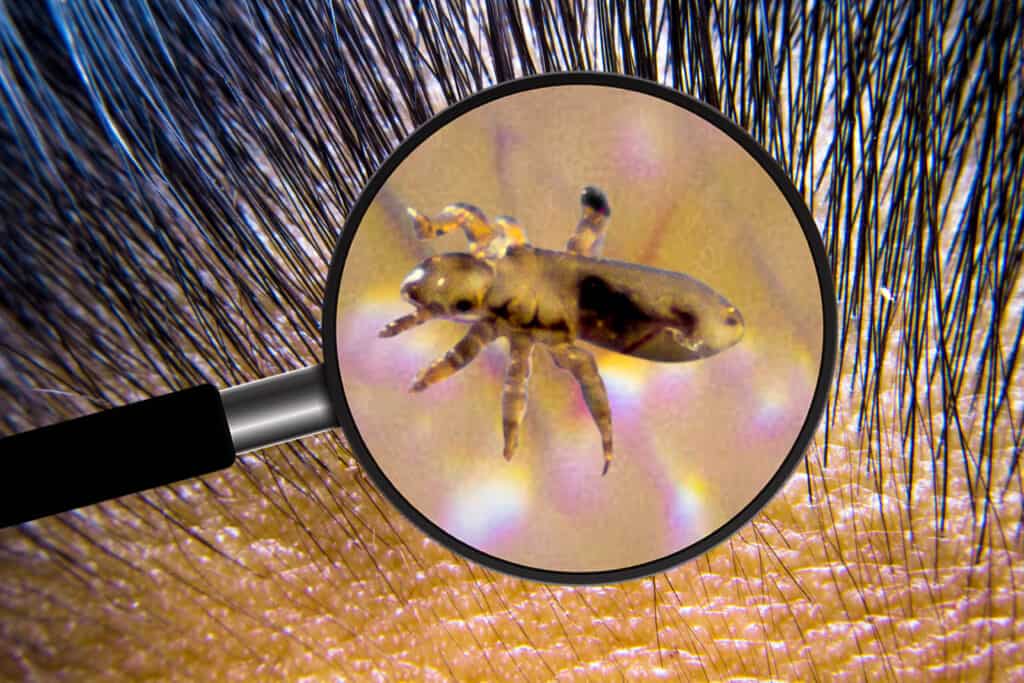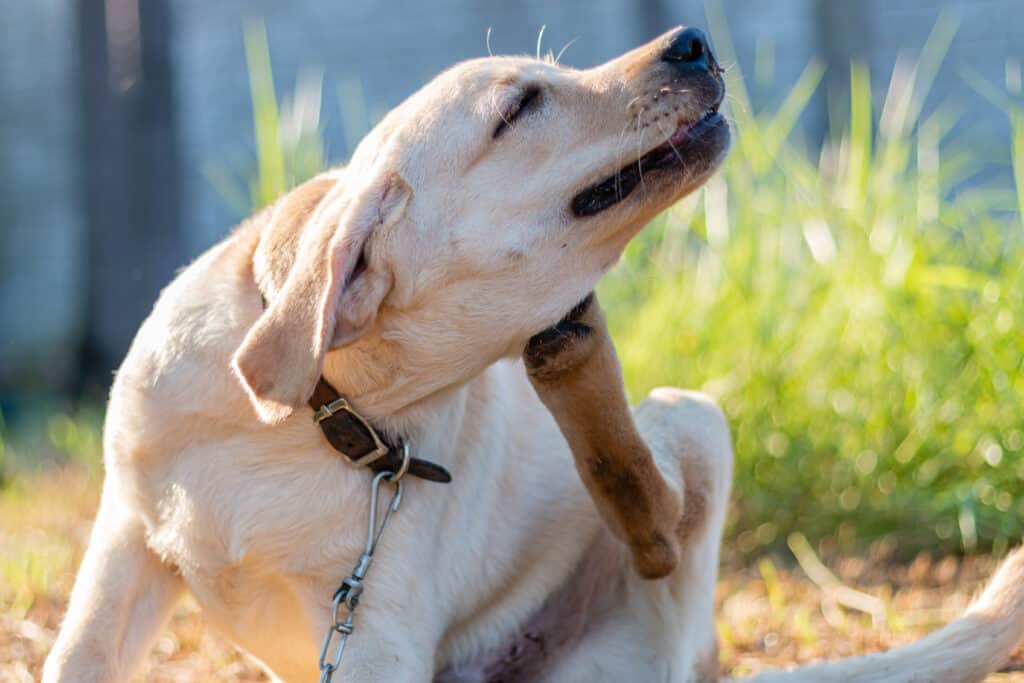No matter who you are or where you’re from, you have likely heard of the dreaded critters known as lice. Lice have a way of sneaking into their host’s life and wreaking havoc, leaving a path of itch and inconvenience in their wake. If someone in your home currently has lice, you might be wondering if it could spread to other species. We know lice can transfer from person to person, but can it spread to our dogs or other pets? Let’s break down all the details about dog lice below!
Lice – What Are They?
Lice are tiny parasites that attach themselves to the surface of their host’s skin and feed on their blood. These tiny critters cause severe itchiness with their bite. Even just moving across the skin can lead to significant irritation. Most forms of female lice can lay up to eight eggs per day. They will continue this egg-laying cycle for just over two weeks. A lice infestation can quickly grow out of control, which is why nobody wants to fall victim to lice.

Lice are tiny parasites that attach themselves to the surface of their host’s skin and feed on their blood.
©narong sutinkham/Shutterstock.com
Can Dogs Get Lice?
Like many other types of mammals, dogs can get lice. Lice in dogs are very similar in appearance to the lice we see in humans. They are also wingless, six-legged, and grow no larger than a grain of rice. Lice in dogs also burrow into their fur and attach themselves to strands of fur, which allows them to crawl down to the skin and feed on blood. Some uncommon forms of dog lice also feed on dead skin and skin oils.
Lice in mammals are species-specific, so this means that dog lice can only survive on dogs. Your dog’s lice cannot spread to humans or other animals. If your dog has lice, he either caught it from another infested dog or from bedding or grooming tools that a lice-infected dog came in contact with.
What Are the Signs of Lice in Dogs?
Spotting lice in dogs can be tricky, as there are many conditions that cause them to itch. The best a pet parent can do is simply pick up on the skin irritation your dog is experiencing. Realize that it is time to bring your pup to the vet. We list the most common signs of lice in dogs below:
- Constantly scratching or chewing at their skin
- Dry skin and a lackluster coat
- Appearing restless or agitated
- Small wounds on the skin
- Bacterial infections of the skin
- Excessive fur loss, especially around the ears, shoulders, neck, and hind end
- Evidence of tapeworms in their stool (worms that look like grains of rice)
If you notice any of the above symptoms in your dog, we suggest having her seen by your veterinary team. These symptoms can also be seen in dogs with fleas or skin mites, but these ectoparasites require veterinary treatment as well. Your vet can perform an exam and skin scraping test to diagnose the exact critter responsible for your dog’s irritation.

Scratching is, of course, one of the major signs your dog has lice.
©Sommai Iam/Shutterstock.com
How Do You Treat Lice in Dogs?
Thankfully for the lice-infested pup in your life, it is usually very easy to treat lice in dogs. Most flea and tick prevention will kill the fleas on your dog, as well as protect him from other irritating critters that feed on their skin. In fact, most dogs that are on monthly flea and tick prevention will not develop a case of lice. Their prescribed prevention keeps these itchy critters at bay.
If your pup recently had lice, you also need to treat your home. You do not want a flea infestation in your home! We suggest throwing out any bedding you can stand to lose. Alternatively, you can wash your dog’s bedding in hot water treated with lice spray. Fumigation is not usually recommended for lice. It’s best to just be thorough about washing any fabrics around your home. Also, clean surfaces with diluted bleach.
Can Dogs Catch Lice from Humans?
As we mentioned above, each mammal has a form of lice that is species specific. This means that dog lice can only spread to dogs, while human lice can only spread to humans. Each type of lice can only survive on their species of interest, so you do not have to worry about giving your dog lice, or vice versa. This also means that you can rest assured when your dog is diagnosed with lice. These tiny creatures are not interested in the humans inside your home.
Do Other Pets Get Lice Too, & Can They Spread It?
Almost all mammals have their own form of lice that can cling to their fur and cause irritation. Lice can survive in everything from hair to feathers, so virtually every warm-blooded creature can catch them. As we’ve discussed in detail above, lice in other animals can only spread to animals of the same kind. The only time you have to worry about animal lice spreading is if you have another animal of the same species.
Final Thoughts
Lice are a nuisance that impact furry friends of all kinds. Thankfully, each type of lice is species-specific and will not infect other types of animals. Review the symptoms of lice we discussed above and keep an eye out for these symptoms in the future. By taking your pet to the vet the moment you notice skin irritation, you can get rid of pesky lice!
The photo featured at the top of this post is © Photo-Vista.de/Shutterstock.com
Ready to discover the top 10 cutest dog breeds in the entire world?
How about the fastest dogs, the largest dogs and those that are -- quite frankly -- just the kindest dogs on the planet? Each day, AZ Animals sends out lists just like this to our thousands of email subscribers. And the best part? It's FREE. Join today by entering your email below.
Thank you for reading! Have some feedback for us? Contact the AZ Animals editorial team.






